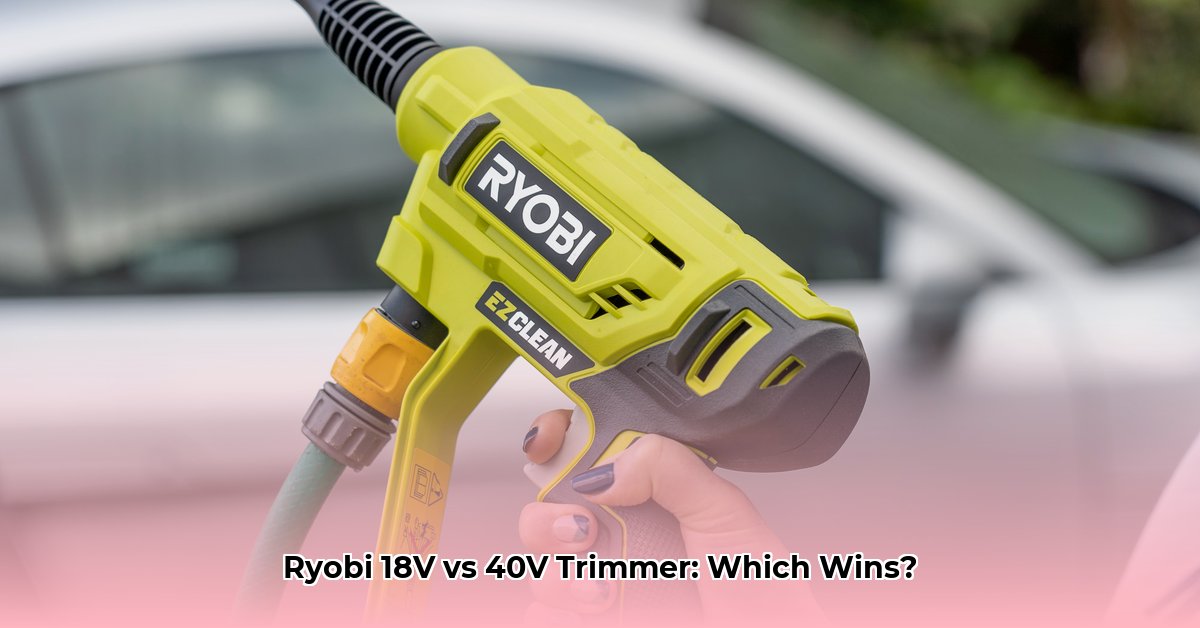Choosing the right cordless string trimmer can be challenging, with numerous options available. Ryobi’s 18V and 40V models offer distinct advantages, but understanding which one best suits your yard is essential. This guide compares power, battery life, weight, and price, while also considering Ryobi’s ONE+ system, empowering you to make yard work efficient and enjoyable.
Understanding Ryobi’s Cordless Trimmer Lineup
Selecting a cordless trimmer doesn’t have to be daunting. We’ll break down the key differences between Ryobi’s 18V and 40V cordless trimmers, ensuring you find the perfect balance of performance and value.
Power Comparison: Matching Voltage to Your Needs
The primary distinction between these models is the voltage—18V versus 40V. Think of an 18V trimmer as a nimble tool for light touch-ups, while a 40V trimmer is a robust machine ready for tougher challenges. What real-world performance differences can you expect?
- 18V Ryobi: Ideal for smaller yards and light trimming tasks such as edging flowerbeds or maintaining delicate plants. Its lighter weight reduces user fatigue, making it perfect for quick maintenance. The 18V models typically feature a 10-12 inch cutting swath.
- 40V Ryobi: A powerhouse designed for larger properties, capable of handling thick weeds and overgrown areas with ease. While it offers more cutting power and a wider 13-15 inch cutting swath, it also adds weight and cost. Suited for extensive yards that demand a tool capable of tackling demanding tasks.
Battery Life and Charging: Staying in Power
Battery life is a crucial consideration. Both 18V and 40V trimmers offer adequate runtime, but it varies based on usage intensity and session length. For larger yards, a spare battery is highly recommended to avoid interruptions. Ryobi’s 40V batteries often include a fuel gauge to easily check the charge level. Keep in mind that the 40V battery adds more weight.
The Ryobi ONE+ System: One Battery, Many Tools
Ryobi’s ONE+ system is a significant advantage. It allows you to use a single battery across a wide range of Ryobi tools, saving money and storage space. However, this benefit is most valuable if you already own or plan to expand your Ryobi tool collection within the ONE+ system. If this is your first Ryobi purchase, ONE+ might not be the deciding factor. The ONE+ system boasts over 260 tools compatible with the same battery platform.
Feature Comparison: A Detailed Breakdown
Let’s compare key features in detail:
| Feature | 18V Ryobi Cordless Trimmer | 40V Ryobi Cordless Trimmer |
|---|---|---|
| Power | Suitable for small to medium-sized yards with light trimming needs. | Excellent power for tackling demanding tasks in larger, tougher yards. |
| Weight | Lighter, offering easy handling and reduced fatigue during extended use. | Heavier, which may affect maneuverability during longer jobs. |
| Runtime | Varies with usage; having a spare battery is highly recommended. | Similar to 18V; multiple batteries are advisable for larger properties. |
| Price | Generally more affordable, ideal for budget-conscious homeowners. | Typically more expensive, reflecting its enhanced power and features. |
| Best Suited For | Smaller yards, maintaining neat edges, trimming around delicate plants, lighter workloads. | Larger yards, heavier-duty trimming, tackling overgrown areas, demanding and frequent jobs. |
Step-by-Step Guide to Selecting the Perfect Trimmer
Choosing the right trimmer requires careful consideration:
- Assess Your Yard: Accurately measure your yard’s size and evaluate the type of trimming tasks you’ll perform.
- Define Your Needs: Determine if you need a powerful tool for managing thick overgrowth or a lighter one for routine maintenance.
- Set a Budget: Establish a realistic budget, considering potential costs for extra batteries and accessories.
- Read Customer Reviews: Research user reviews, paying attention to both positive and negative feedback to gain insights into real-world performance.
- Decide on the Right Voltage: Choose 18V for smaller yards with lighter tasks, or 40V for larger yards with more demanding needs.
- Evaluate the ONE+ System: Consider how the ONE+ system fits into your existing or planned Ryobi tool collection.
- Purchase from a Reputable Retailer: Buy from a trusted retailer that offers easy returns or exchanges if needed.
Safety Guidelines: Addressing Potential Hazards
Safety is paramount when using any power tool. Always wear safety glasses and gloves, and strictly adhere to manufacturer instructions. Awareness of potential safety risks is crucial.
- Potential Issue: Battery malfunctions (failure, reduced run time). Solution: Invest in a spare battery and follow charging instructions precisely. Store batteries in a cool, dry place when not in use.
- Potential Issue: Line breakage (causing injury or damage). Solution: Use the recommended line thickness for your trimmer, avoid hitting hard objects like rocks, and replace worn or damaged lines promptly.
- Potential Issue: Injury (cuts, bruises, etc.). Solution: Wear appropriate safety gear, including long pants and closed-toe shoes, and maintain a cautious and controlled approach to trimming.
Selecting the right Ryobi cordless trimmer involves aligning your lifestyle and yard size with the tool’s capabilities. With the right knowledge, yard work can become both efficient and enjoyable. Happy trimming!
Choosing the Best Ryobi Cordless String Trimmer for Your Yard
Key Takeaways:
- Ryobi offers both 18V and 40V cordless string trimmers. Your yard’s size and vegetation density are the most important factors in making a decision.
- 18V models are lighter, more affordable, and ideal for smaller yards needing simple trimming.
- 40V models offer more power and extended use, making them suitable for larger properties with thicker weeds; however, they are heavier and more expensive.
- The Ryobi ONE+ system provides compatibility across a variety of tools, making it a significant factor if you already own other Ryobi equipment.
- Assess your yard’s size, vegetation type, and budget before making a purchase.
Ryobi 18V vs. 40V: The Voltage Advantage
Deciding between Ryobi’s 18V and 40V string trimmers can be likened to choosing between a nimble sports car and a powerful truck. The decision depends on the tasks.
18V ONE+ String Trimmers: The champions of portability and easy handling, ideal for smaller yards and users who need easy maneuverability. Easy on the wallet, but may struggle with larger yards or thick weeds. Many 18V models include features like automatic line feed for added convenience.
40V HP Brushless String Trimmers: The workhorses, packing power for heavy-duty jobs. Ideal for larger yards and tough vegetation, these trimmers feature impressive power and longer runtimes. Heavier and more expensive. Brushless motors offer increased efficiency and durability.
| Feature | Ryobi 18V ONE+ | Ryobi 40V HP Brushless |
|---|---|---|
| Power | Lower | Higher |
| Weight | Lighter, easier to handle | Heavier |
| Runtime | Shorter | Longer |
| Price | More affordable | More expensive |
| Ideal Yard Size | Small to medium, light to moderate vegetation | Large, dense vegetation |
Expanding with the Ryobi ONE+ System
Ryobi’s ONE+ system simplifies tool management. ONE+ means One battery to power many tools. If you already own Ryobi 18V tools, an 18V trimmer is likely your best choice. The system offers flexibility and efficiency for homeowners.
Other Key Features
Beyond voltage, consider these features:
- Shaft Type: Straight shafts offer better reach, while curved shafts are easier to maneuver around obstacles. Telescopic shafts are also available for adjustable height.
- Line Type: Different lines have varying cutting capabilities. Research carefully to understand what is best for your grass and weeds. Look for models that offer easy line replacement systems.
- Additional Attachments: Some models include attachments like edgers or cultivators to increase versatility.
A Step-by-Step Guide
- Evaluate Your Yard: Measure yard size and vegetation density.
- Assess Your Needs: Determine if you need a lightweight trimmer for occasional use, or a powerful one for heavier trimming.
- Consider Your Budget: Set a price range.
- Check Compatibility: Ensure compatibility with ONE+ system tools.
- Read Reviews: Consult customer reviews.
Careful consideration ensures you will find the Ryobi cordless string trimmer that best meets your needs.
- White On White Kitchen Backsplash: Is It Timeless? - November 20, 2025
- Backsplash Colors for White Cabinets: Find Your Perfect Match - November 19, 2025
- Backsplash Ideas for White Cabinets: Find Your Perfect Style - November 18, 2025










